Rash That Has Continued to Spread Up From His Chest to His Face and Behind His Ears
Skin rashes in children
Childhood rashes are common. Most rashes are harmless and disappear without the need for treatment. See your GP or call GP out of hours service if your child has a rash and seems unwell, or if you're worried.
About skin rashes in children
It's especially important to be aware of the symptoms of meningitis, see section below.
Also below is information on some of the most common rashes in children.
This guide may give you a better idea of the cause of the rash. But don't rely on it to diagnose your baby's condition if they show any signs of being unwell. Always see a GP or contact a GP out of hours service for a proper diagnosis.
- read about causes of skin rashes in babies
Cellulitis
Cellulitis is an infection of the deeper layers of skin and underlying tissue.
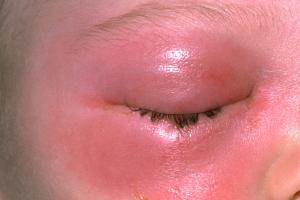
About cellulitis
- the affected area will be red, painful, swollen and hot
- it often affects the legs, but can occur anywhere on the body
- your child will probably also have a fever
Contact your GP or GP out of hours service if an area of your child's skin turns red, hot and tender. Do this immediately if your child appears unwell. Cellulitis usually responds well to treatment with antibiotics.
Chickenpox
Chickenpox is a viral illness that most children catch at some point. It most commonly affects children under 10 years of age.
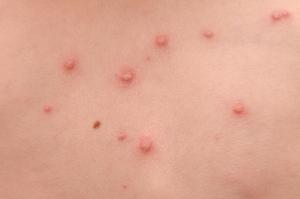
About chickenpox
- it causes a rash of itchy spots that turns into fluid-filled blisters
- they crust over to form scabs, which after a while drop off
- some children only have a few spots, others have them over their entire body
- the spots are most likely to appear on the face, ears and scalp, under the arms, on the chest and belly, and on the arms and legs
There's no specific treatment for chickenpox. You can take steps to relieve the symptoms. For example, paracetamol can help relieve fever (don't give aspirin to children under 16). Calamine lotion and cooling gels can be used to ease itching.
Eczema
Eczema is a long-term condition that causes the skin to become itchy, red, dry and cracked. The most common type is atopic eczema, which mainly affects children but can continue into adulthood.
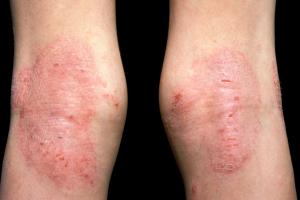
About atopic eczema
- commonly develops behind the knees or on the elbows, neck, eyes and ears
- it isn't a serious condition, but if your child later becomes infected with the herpes simplex virus, it can cause the eczema to flare up into an outbreak of tiny blisters and will cause a fever
Erythema multiforme
Erythema multiforme is a skin rash (usually mild). It is caused by an allergic reaction to the herpes simplex virus.
About Erythema multiforme
- the spots look like targets, with a dark red centre and paler ring around the outside
- the hands or feet tend to be affected first, followed by the limbs, upper body and face
- your child will probably feel unwell and may have a fever, which you should be able to treat with over-the-counter medicine
- it may take from two to six weeks before they feel better
See your GP if your child has a rash and seems unwell.
In rare cases, erythema multiforme can be triggered by a reaction to certain medications, such as an antibiotic or anticonvulsant.
This more severe form is called Stevens-Johnson syndrome and it can be life-threatening.
Hand, foot and mouth disease
Hand, foot and mouth disease is a common, contagious infection.
About hand, foot and mouth disease
- causes mouth ulcers and spots and blisters on the palms of the hands and soles of the feet
- it's most common in young children (particularly those under 10), but it can also affect older children and adults
There's no cure for hand, foot and mouth disease. It's easily spread, so you should keep your child away from school or nursery until they're better.
Your child's immune system will fight the virus. It should clear up after about seven to 10 days.
Make sure your child drinks plenty of fluid. If eating and swallowing is uncomfortable for them, give them soft foods, such as mashed potatoes, yoghurt and soup.
Impetigo
Impetigo is a common and highly contagious skin infection that causes sores and blisters. It is caused by bacterial infection. It isn't usually serious and often improves within a week of treatment.
There are two types of impetigo – bullous and non-bullous.
About bullous impetigo
- typically affects the trunk (the area of the body between the waist and neck)
- causes fluid-filled blisters that burst after a few days to leave a yellow crust
About non-bullous impetigo
- typically affects the skin around the nose and mouth
- causes sores that quickly burst to leave a yellow-brown crust
See your GP if you think your child has impetigo. If it is impetigo, antibiotics will usually be prescribed. This is an effective treatment, clearing up the infection.
Keratosis pilaris ('chicken skin')
Keratosis pilaris is a common and harmless skin condition.
About keratosis pilaris
- the skin on the back of the upper arms becomes rough and bumpy, as if covered in permanent goose pimples
- sometimes, the buttocks, thighs, forearms and upper back can also be affected
- typically begins in childhood and gets worse during puberty
- some people find it improves after this and may even disappear in adulthood
There's no cure for keratosis pilaris.
It often gets better on its own without treatment.
There are some measures you can take that may improve your child's rash. These include using non-soap cleansers rather than soap, and an emollient to moisturise their skin.
Your GP or pharmacist will be able to recommend a suitable cream.
Measles
Measles is a highly infectious viral illness that most commonly affects young children. It's now uncommon in Northern Ireland because of the effectiveness of the measles, mumps and rubella (MMR) vaccination programme, with high levels of vaccination.
About measles
- the measles rash is red-brown blotches
- it usually starts on the face, head or upper neck and then spreads outwards to the rest of the body
- your child may also have a fever and cold-like symptoms
Call your GP surgery if you think your child has measles. It's best to phone before visiting. This is because the surgery may need to make arrangements to reduce the risk of spreading the infection to others.
Measles usually passes in about seven to 10 days without causing further problems. Paracetamol or ibuprofen can be used to relieve fever, aches and pains (don't give aspirin to children under 16).
Also, make sure your child drinks plenty of water to avoid dehydration.
Molluscum contagiosum
Molluscum contagiosum is a viral skin infection.
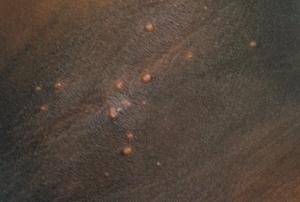
About molluscum contagiosum
- causes clusters of small, firm, raised spots to develop on the skin
- commonly affects young children aged one to five years, who tend to catch it after close physical contact with another infected child
- is usually painless, although some children may experience some itchiness
- usually goes away within 18 months without the need for treatment
Molluscum contagiosum is highly infectious. Most adults are resistant to the virus. This means they're unlikely to catch it if they come into contact with it.
Pityriasis rosea
Pityriasis rosea is quite a common skin condition.
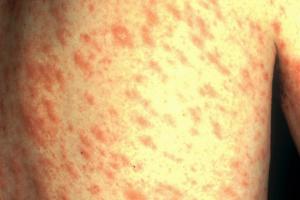
About pityriasis rosea
- causes a temporary rash of raised, red scaly patches to develop on the body
- most cases occur in older children and young adults (aged between 10 and 35)
- the rash can be very itchy
- in most cases, it clears up without treatment in two to 12 weeks
- in rare cases it can last up to five months
Emollients, steroid creams and antihistamines can be used to help relieve the itchiness. The rash doesn't usually leave scars. The skin can sometimes be discoloured afterwards.
Prickly heat (heat rash)
Prickly heat (heat rash) is also known as miliaria.
About prickly heat (heat rash)
- it is an itchy rash of small, raised red spots that causes a stinging or prickly sensation on the skin
- it occurs when the sweat ducts in the outer layer of skin (epidermis) are obstructed
- you can get a heat rash anywhere on your body, but the face, neck, back, chest or thighs are most often affected
- infants can sometimes get a prickly heat rash if they sweat more than usual – for example, when it's hot and humid or if they're overdressed
It isn't a serious condition and rarely requires any specific treatment.
Psoriasis
Psoriasis is a long-lasting (chronic) skin condition.
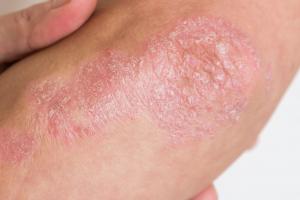
About psoriasis
- that causes red, flaky, crusty patches of skin covered with silvery scales
- the severity of psoriasis varies greatly from person to person- for some people, it's just a minor irritation, but for others it can have a major impact on their quality of life
There's no cure for psoriasis.
There are a number of treatments, available through your GP, which can help improve the symptoms and appearance of skin patches. For example, topical corticosteroids are creams and ointments that can be applied to the skin.
Ringworm
Ringworm is a highly infectious fungal skin infection.
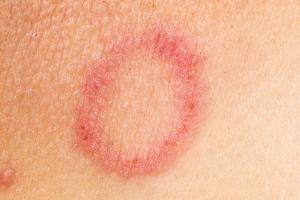
About ringworm
- causes a ring-like red or silvery patch on the skin that can be scaly, inflamed or itchy
- often affects the arms and legs, but it can appear almost anywhere on the body
Other similar fungal infections can affect the scalp, feet, groin and nails.
Ringworm can usually be easily treated with antifungal medicines. These are available from a pharmacy. Ask your pharmacist if you need advice about treatment.
Ringworm of the scalp can cause scaling and patches of hair loss.
Scabies
Scabies is a contagious skin condition that's intensely itchy.
About scabies
- it's caused by tiny mites that burrow into the skin
- in children, scabies is usually spread through long periods of skin-to-skin contact with an infected adult or child – for example, during play fighting or hugging
- the mites like warm places, such as skin folds, between the fingers, under fingernails, or around the buttock creases
- the mites leave small red blotches, which are often found on the palms of the hands or soles of the feet
- in infants, blisters are commonly found on the soles of the feet
See your GP if you think your child has scabies. It's not usually a serious condition, but it does need to be treated. Your GP will prescribe a lotion or cream.
Scarlet fever
Scarlet fever is a highly contagious bacterial infection.
About scarlet fever
- usually affects children between two and eight years of age
- causes a distinctive pink-red rash, which feels like sandpaper to touch and may be itchy
- often starts with a sore throat, fever and headache, with the rash developing two to five days after infection
- the rash usually occurs on the chest and stomach before spreading to other areas of the body, such as the ears and neck
- sometimes a white coating may form on the tongue, which peels away after a few days, leaving the tongue red and swollen - this is known as a 'strawberry tongue'
Scarlet fever usually clears up after about a week. But see your GP if you think your child may have it. Your GP will prescribe an antibiotic to treat it.
Slapped cheek syndrome
Slapped cheek syndrome is a viral infection that's common in children aged six to 10.
About slapped cheek syndrome
- causes a distinctive bright red rash to develop on both cheeks
- this can look alarming, but it usually clears up by itself in one to three weeks
Unless your child is feeling unwell, they don't need to stay away from school.
Once the rash appears, the infection is no longer contagious. It's a good idea to let your child's school know about the infection.
Urticaria (hives)
Urticaria is also known as hives, weals, welts or nettle rash.
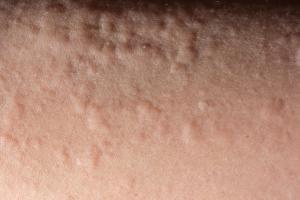
About hives
- is a raised, itchy rash that can affect one part of the body or be spread across large areas
- it's a common skin reaction that often affects children
- occurs when a trigger causes high levels of histamine and other chemical messengers to be released in the skin
- these substances cause the blood vessels in the skin to open up, resulting in redness or pinkness, and swelling and itchiness
There are many possible triggers of urticaria, including allergens, such as food or latex, irritants, such as nettles, medicines, and physical factors, such as heat or exercise. Sometimes, a cause can't be identified.
The rash is usually short-lived and mild. It can often be controlled with antihistamines. Ask your pharmacist for advice. Urticaria can be one of the first symptoms of a severe allergic reaction known as anaphylaxis.
Call 999 immediately and ask for an ambulance if you or someone else is experiencing anaphylaxis.
Meningitis
Meningitis is an infection of the protective membranes that surround the brain and spinal cord (meninges).
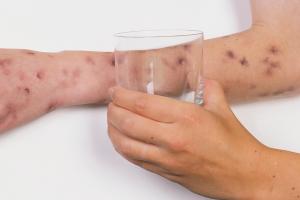
About meningitis
- the classic rash associated with meningitis usually looks like small, red pinpricks at first
- it then quickly spreads over the body and turns into red or purple blotches that won't fade when a glass is rolled over it (this won't always develop)
Meningitis can be serious if not treated quickly.
Call 999 for an ambulance or go to your nearest emergency department if you think you or your child might be seriously ill.
More useful links
- How to use your health services
The information on this page has been adapted from original content from the NHS website.
For further information see terms and conditions.
cranwellhincture1985.blogspot.com
Source: https://www.nidirect.gov.uk/conditions/skin-rashes-children